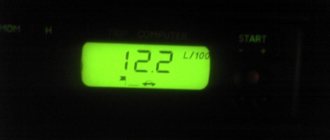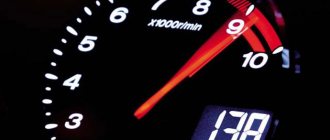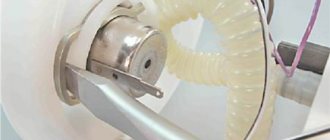The most popular “classic”, the VAZ 2107 model, first rolled off the assembly line in 1982. It differed from previous models in its richer equipment, comfort, and modern appearance. The car was equipped with gasoline engines of various sizes with a manual transmission. They are all different:
- reliability;
- maintainability;
- efficiency;
- long engine life;
- constructive simplicity.
Due to its high popularity, the car was produced for more than 30 years. To reduce the engine's appetite, injectors began to be installed on the VAZ 2107, which made it possible to significantly reduce fuel consumption by 100 km.
Gasoline consumption data for VAZ 2107 (reviews)
Starting in 2006, for the domestic market, the “seventh” model began to be equipped with a 1.6 liter engine with forced injection, which complied with Euro-2 standards. At the same time, the power, compared to the carburetor supply of the mixture, decreased slightly - to 50 kW. The plant guaranteed the following indicators when using AI-95 gasoline:
- urban mode - 8.5 l;
- 90 km/h - 6.9 l;
- 120 km/h – 9.2 l.
The use of a new injection system allows you to get rid of the constant adjustments inherent in the carburetor; idle speed is always stable. Dosage occurs using an electronic control unit, which is guided by sensor readings
:
- throttle position;
- crankshaft position;
- oxygen concentration;
- air consumption;
- coolant temperature.
In addition to changes in the electrical circuit of the VAZ 2107i, the following innovations were applied:
- hydraulic chain tensioner;
- hydraulic valve compensators.
These components made the engine quieter and freed the car enthusiast from such an important operation as adjusting the valves.
Chassis
The basic basis for the VAZ-21053 model was the 2101 platform. There were no design changes, except for rearranging the brackets when releasing export modifications with right-hand drive.
The front suspension of the VAZ-21053 is two independent units (left and right), consisting of profiled stamped arms that are attached to the transverse beam using silent blocks. The ends of the levers are connected to the steering axle by means of ball joints. Each pair of levers rests on a steel spiral spring, which, with its upper ring, fits into a special socket mounted in the sides of the engine compartment. A hydraulic shock absorber is installed in the middle of the spiral. Both lever units are connected to each other by a rod, which dampens vibrations and ensures lateral stability of the car.
The rear suspension of the pendulum design consists of trailing arms connecting the underbody to the axle beam. Spring coils along with shock absorbers are also an integral part. The lateral stability of the car is ensured by a special stabilizer beam located behind the rear axle.
VAZ 2107 injector details about fuel consumption
To save money when refueling a car, motorists recommend installing gas-cylinder equipment; gas is consumed in this case, but the fuel itself costs almost half as much, especially methane refueling is inexpensive. The engine from the VAZ-2106 was installed on the VAZ-21074 without changes; among other things, the camshaft chain drive was left, which, compared to the belt drive used in the VAZ-2105, is more durable and reliable, although noisier.
Salon
Inside, the car looks the same as the “four” and “seven”. The driver has a four-spoke steering wheel without any adjustment and a flat fabric seat. The instrument panel on the VAZ-21053 is a pointer panel with modest backlighting. Nevertheless, everything necessary was located here: speedometer, tachometer, fuel level and antifreeze temperature sensor.
By the way, the “five” became the first car among the “Classics”, which was standardly equipped with a heated rear window. In addition, the front door windows have been ventilated in the cabin. However, in order to place deflectors in the panel, it was necessary to reduce the already small-sized glove compartment. The interior here is so simple that the only electronic items are interior lighting and rear window heating. All window regulators are mechanical. The seats are manually adjustable. Among the shortcomings in the interior, the owners note:
- Poor sound insulation. It is very noisy inside, especially at speed, when the roar of the engine can be heard from under the hood.
- Uncomfortable seats. Although they received height-adjustable headrests, they were extremely uncomfortable. There was no lumbar and lateral support. In addition, the seats quickly sank and rubbed. Because of this, you could often see covers on the seats of Zhiguli cars.
- Bad ergonomics. In particular, this concerned the steering wheel and inconvenient controls on the stove.
Tire pressure • Engine 13 with carburetor
If the VAZ 2107, or more precisely, its carburetor, still consumes a lot of gasoline and has difficulty starting, then you should check the cleanliness of the fine and coarse filters. The colder it is, the more starts there are per day, and on weekends you sometimes don’t go out, and at a temperature of about -30, per day the car starts on average 5-6 times, again for 10 minutes.
| Engine 1.6 liters | Highway consumption, l/100 km | Consumption in the city, l/100 km | Combined cycle, l/100 km |
| carburetor | 6,9 | 10,2 | Around 9 |
| injector | 7,3 | 9,7 | Around 9 |
Statistics
The fuel consumption of a Lada 2107 with an injection engine is perfectly shown by statistics provided by the manufacturer and figures received from car enthusiasts.
The manufacturer claims that when driving on the highway, the car will normally consume 9 liters of gasoline, but in reality we see that consumption does not exceed 7.75 liters.
Driving in urban conditions should consume only 9.70 liters, but here the figure exceeds 10.25 liters. With a mixed type of driving, the readings from the manufacturer and the car enthusiast practically coincided, the former had a consumption of 8.50 liters, and the latter - from 8.82 liters. However, we see that in practice the consumption is higher.
The passport does not indicate how much gasoline is consumed when driving off-road. Having checked it ourselves, we see that such driving requires more than 9 liters of fuel.
Reasons for overspending
To determine the causes, technicians use a special device - a tester. They check the electronic control unit and sensors. There are several main reasons when fuel consumption may increase:
- Aggressive driving.
- Precipitation on the walls of nozzles, measurement of their flow area.
- Incorrect operation of the sensors.
- The glow number of the spark plugs does not correspond to that stated by the manufacturer.
- The car's air engine is clogged.
VAZ-2104 engine and its features
Engine 2104-1000260
can be used for installation on VAZ 2103, 2104, 2106, 21053, 2107 cars. Initially, the VAZ 2104 engine was produced only in a carburetor version. Subsequently, it was modified to use a fuel injection system and received the designation VAZ 2104-21. The VAZ 2104 engine was created on the basis of the previous model - VAZ 2103. The design used: a cylinder block, a connecting rod and piston group, a timing drive and a crankshaft from the 2103 engine.
photo VAZ-2104 engine
Cylinder block from a VAZ 2103 engine. Cylinder diameter - 76.00 mm. The accepted overhaul dimensions are 76.40 and 76.80. The engine is equipped with a crankshaft 2103 or an interchangeable shaft model 21213. To ensure the operation of the injection system, it was necessary to install components and parts from other engines that were originally developed for an injection fuel supply system. A new camshaft drive cover is used, on which there is space for installing a sensor that controls the position of the crankshaft. It was necessary to install cylinder head 2104-1003015, an original design, with enlarged areas for the intake manifold. The design of the head provides for the installation of nozzles. The camshaft, valves and springs correspond to those installed on the VAZ 2103 engine. The installation of hydraulic supports for the valve levers is not provided. The timing drive is carried out from a double-row bush-roller chain 2103-1006040. The chain tensioning mechanism is mechanical, similar to the device on the VAZ 2103 engine.
A pulley with a damper and a drive disk 21214-1005058-11 is installed on the crankshaft. To drive the generator, a belt 2107-1308020 is used (length - 944 mm). The injection modification 2104 has an original power system. The system includes an electric fuel pump with a fuel level indicator sensor, fuel lines, a fuel filter, a fuel rail with injectors, an air filter, air supply hoses, a throttle valve and a fuel vapor recovery system. To clean the air entering the engine, an air filter model 2112 is installed. A receiver model 2104 or model 2123-1008027 is installed together with the intake manifold. To adjust the volume of incoming air, a throttle pipe 2112 is installed. The electric fuel pump module 21073-1139009 is installed in the tank and supplies fuel to the fuel rail and injectors. The original fuel rail 2104-1144010 is used, box type with pressure regulator and return drain pipe. Injection is carried out using four nozzles of pair-parallel action. It is possible to install nozzles BOSCH 0 280 158 502 (black, thin), SIEMENS VAZ 6393 (beige, thick) or other types with the appropriate parameters. The ignition system includes: a Model 2112 ignition module mounted on a special bracket on the cylinder block, spark plugs and high voltage wires. The ignition module includes two ignition coils and two electronic control devices. In accordance with control signals from the control unit, the ignition module generates and supplies high-voltage pulses to the spark plugs. Ignition control is assigned to the electronic engine management system. This system controls the amount of air and fuel supplied to the cylinders, controls the operation of the fuel pump, controls the supply of high-voltage pulses from the ignition coil to the spark plugs and adjusts the ignition timing, regulates the crankshaft speed at idle. The main control element of the system is the electronic control unit (ECU)-controller. The engine complies with EURO-2 toxicity standards.
The VAZ 2104 model was produced until 2012, and in recent years the car was produced in Izhevsk. She received many modifications. Cars of recent years of production were equipped with a radiator grille from the VAZ 2107.
VAZ 2107: fuel consumption per 100 km
If we take into account that the injector is more capricious and finicky in terms of fuel quality and settings requirements, then the advantage in fuel consumption is completely leveled out. Justification remember the simple formula: in 1st gear, start from a standstill, for acceleration there is 2nd gear, for afterburner and overtaking there is 3rd, in 4th gear you move around the city, and in 5th gear you can switch to the highway.
Autonomous mileage after switching to gas
If the wheel alignment angles set during the wheel alignment process change for some reason, this leads not only to premature wear of the car tires, but also to an increase in fuel consumption by 2–3%. Wheels turned at unnatural angles resist the vehicle's rolling more strongly, which ultimately leads to increased fuel consumption. Identifying this problem is quite simple: tires that are worn on one side speak eloquently about it. At the same time, the car may begin to pull to the side while driving, and it will become more difficult to rotate the steering wheel.
Driving in neutral gear Engine 15 with injector
| Fuel consumption standards for VAZ 21074 injector It should be noted that this driving style is dangerous if the engine stalls, the vacuum brake booster stops working, braking efficiency noticeably decreases, which leads to an emergency. All advice can be divided into two groups: real, which bring practical benefits, and dubious, which only benefit sellers of sophisticated devices for reducing fuel consumption. |
| Consumption of a VAZ 2107 carburetor in winter Sometimes motorists give advice on how to save the most money on the Republic of Tatarstan, but not all the proposed methods work, and often savings using such methods turn out to be incomprehensible. It must be emphasized that idling is far from the most economical mode; if you measure the CO level with a gas analyzer, then at idle the device will show the emission of harmful impurities in the exhaust gases no less than at medium speeds. |
- hydraulic chain tensioner;
- hydraulic valve compensators.
Aggressive driving style • All drivers should know that without oxygen, fuel combustion is impossible.
Questionable ways to adjust fuel consumption
Questionable methods for reducing gasoline consumption on both carburetor and injection engines include installing fuel activators on hoses or adding additives to the tank. Magnetic treatment of the hydrocarbon flow does not affect the processes of formation of the working mixture and combustion, so the installation of activators does not bring results. The owner may note a change in consumption of 0.1-0.3 liters, which is a statistical error and is associated with unstable quality of gasoline or a change in the road situation.
Adjusting the carburetor to excessively lean the working mixture and reducing idle speed leads to unstable operation of the engine, which stalls when the speed is reduced. Some owners, when driving downhill, move the gearbox lever to the neutral position. If the engine stops, the brake booster stops working. On a long descent, you must leave the gear engaged and release the accelerator pedal (switch to engine braking mode). Cutting off the fuel supply improves efficiency.
The use of additives negatively affects engine parts on which carbon deposits form, causing glow ignition and disrupting the normal operation of the engine. Until the beginning of the 90s. last century, due to a shortage of AI-93 gasoline, it was practiced to convert engines to fuel with a lower octane number (for example, A-76 was widely used to refuel trucks). The modification consisted of installing a thicker head gasket and adjusting the ignition timing, but it negatively affected the power and service life of the VAZ-2107 engine.
VAZ 2107: fuel consumption injector
It cannot be said that VAZ injection engines are much more economical than gasoline ones, but with the same gasoline consumption they are much more powerful, cars with such engines have better dynamics, accelerate to one hundred kilometers in a shorter period of time, and the maximum speed is also higher. There are also several modifications of the VAZ-2107 with a fuel injection system:
- 2107-20 – with engine 2104 1.5 l (cylinder block from 2103);
- 21074-20 – with engine 21067 1.6 l (Euro-2);
- 21074-30 – with engine 21067 1.6 l (Euro-3).
Coordination of the microcontroller with sensors
Therefore, some signals need to be amplified and others reduced. For these purposes, intermediate stages (matching devices) are used - operational amplifiers and voltage dividers. This is all clear, but the microprocessor will not be able to turn on even the winding of the electromagnetic relay. For this purpose, special Darlington assemblies are used. This is a small microcircuit; it is based on amplifier stages based on field-effect transistors. They operate in key mode and allow switching currents up to 30 A. This is quite enough to power the winding of an electromagnetic injector.
It is impossible to coordinate the microcontroller with the injectors using an electromagnetic relay. The reason for this is the high pulse frequency. The relay simply will not be able to manage the required number of switchings per second. From this point of view, the switch on the field-effect transistor turns out to be much more efficient.
Video: the owner of a VAZ-21074 injector shares his impressions of the car
Increased fuel consumption is even affected by the condition of the braking system; if one of the working cylinders is faulty, the car will begin to slow down, and the driving resistance will increase in this case. per minute 3750 Number of cylinders 4 Cylinder arrangement in-line Acceleration time to 100 km h, seconds 15 Maximum speed, km h 150 Fuel consumption city highway mixed mode, l 100 km 9.7 7.3 8.5 Gearbox 5-speed manual transmission Independent front suspension multi-link Suspension rear dependent Front disc brakes Rear drum brakes Tire size 175 65 R13 Wheel size 5Jx13 Body type sedan Length, m 4.145 Width, m 1.62 Height, m 1.446 Wheelbase, m 2.424 Ground clearance, cm 17 Front track, m 1.3 65 Rear track, m 1.321 Curb weight, t 1.06 Gross weight, t 1.46 Number of doors 4 Number of seats 5 Rear-wheel drive.
VAZ-2104 “Universal”. History of photography characteristics. Years of manufacture: 1984 - 2012
photo of VAZ-2104 “Universal”
VAZ 2104
- a Soviet passenger car with a station wagon body type, developed at the VAZ plant. Serially produced from 1984 to 2012. The model was developed as a replacement for the outdated 2102 station wagon. For some time, 2102 and 2104 were produced at the plant in parallel. When creating a new model, the plant followed the path of least cost and used the VAZ 2105 as the base model. All spare parts were subject to maximum unification. To add rigidity, stampings appeared on the roof of the new model. Unlike the 2102 model, the “four” was equipped with a heated rear window as standard. From the mid-1990s, a rear windshield wiper was included as standard. The base model received the interior from the 2105. The station wagon's load capacity was 455 kg, almost double the maximum load capacity of the 2102. The model inherited the rear door design from its predecessor. Its edge coincided with the floor level, which made loading and unloading luggage easier. The rear seat folds down to create a huge loading area.
Main ways to reduce consumption and consequences Consumption according to reviews
| Consumption of VAZ 2107 injector in the city; AutoTop air dampers Solex and Ozone are covered air dampers of carburetors 2108, 21081, 21083 Solex and 2105, 2107 Ozone are not fully open due to their incorrectly adjusted drive. Sometimes some car owners, having a worn-out engine in their car, try to resurrect its former throttle response, intentionally setting some closing the carburetor air damper, thus forcibly enriching the fuel mixture and slightly resuscitating the engine's former capabilities. Overestimated fuel consumption is influenced even by the condition of the brake software, which allows accounting, if one of the working cylinders is faulty, the car will begin to slow down, and the resistance to movement will then increase. |
- driving style - during fast dynamic driving, gasoline literally “flies down the drain”;
- season - in winter a lot of fuel is spent on warming up the internal combustion engine;
- the serviceability of the power unit - if the engine is running rough, the fuel does not burn completely, consumption increases;
- tire pressure - with poorly inflated wheels, the resistance to movement increases, and accordingly, the RT increases;
- settings, serviceability of the carburetor itself.
We diagnose ourselves
You can find out for yourself how much fuel is actually consumed. To do this, you need to fill a full tank of gasoline, which is 39 liters, and drive until the gas level indicator is in the middle. This will take more than one hour of moderate driving. Then we go back to the gas station.
We calculate: divide the volume of fuel poured by the mileage on the odometer. This way you will find out the average gasoline consumption of a VAZ 2107 per 100 km. If fuel consumption standards are exceeded, you yourself will not be able to diagnose the exact cause of the problem. Then it is recommended to go to a service station.
How to reduce fuel consumption on a VAZ 2107
RT on VAZ cars with a carburetor engine depends on many factors:
- driving style - during fast dynamic driving, gasoline literally “flies down the drain”;
- season - in winter a lot of fuel is spent on warming up the internal combustion engine;
- the serviceability of the power unit - if the engine is running rough, the fuel does not burn completely, consumption increases;
- tire pressure - with poorly inflated wheels, the resistance to movement increases, and accordingly, the RT increases;
- settings, serviceability of the carburetor itself.
To save money on refueling a car, motorists are advised to install gas-cylinder equipment - gas is consumed no less, but the fuel itself costs at least almost half as much, refueling with methane is especially cheap.
It should be noted that converting a car to gas is beneficial only if the car is used regularly and covers at least 30-40 thousand kilometers per year. The thing is that before you can profit from saving on fuel, you first need to recoup the cost of installing the equipment and the gas equipment itself.
Electric fuel pump
But this is a device that is responsible for ensuring that the required pressure is always present in the ramp. How to reduce fuel consumption will be discussed below. But it is worth noting that the electric pump does not affect this parameter. It is located directly in the tank, combined in a single housing with a gasoline level sensor. It also has a filter. People call it “diaper” due to its external resemblance.
By the way, try to change it as often as possible, otherwise the fuel lines and injectors will become clogged. And cleaning sometimes costs a lot of money. In addition to the electric pump, there is another device that allows you to maintain constant pressure - the regulator on the ramp. With its help, excess gasoline is discharged back into the tank. Therefore, excess pressure for the system is not dangerous.
Do not overuse the lowering of the windows. Engine 15 with injector
RT fuel consumption on cars with carburetor power units depends on the engine size; the smaller the cylinder volume, the less fuel should be consumed. Rationale: try to drive towards the traffic light with the intention of accelerating at the green signal when the car has not yet completely stopped.
| Engine, modification | Fuel consumption in the urban cycle, l/100km | Fuel consumption in the extra-urban cycle, l/100km | Fuel consumption in the combined cycle, l/100km |
| VAZ 2107 (engine 2103, 1.5 l, carburetor, 72 hp) | 9,6 | 7,4 | 8,5 |
| VAZ 21072 (engine 2105, 1.3 l, carburetor, 64 hp) | 9,4 | 6,9 | — |
| VAZ 21073 export version (1.7 l, single injection) | 8,9 | 5,3 | 6,4 |
| VAZ 21074 (engine 2106, 1.6 l, carburetor, 75 hp) | 9,8 | 7,1 | 8,5 |
| VAZ 21074–20 (1.6 l, injector, EURO‑2) | 9,7 | 6,8 | 8,5 |
| VAZ 21074–30 (1.6 l, injector, EURO‑3, 74 hp) | 9,7 | 6,8 | 8,5 |
Briefly about the technical characteristics of the injection engine Motor 16 with an injector
| How to reduce fuel consumption of a VAZ 2107 injector For VAZ models, the optimal economy mode is driving at a speed of 90 km h on a flat road, and in the city with smooth, not slow, but smooth acceleration and braking. If the carburetor consumes gasoline in nominal quantities, then the problem may be hidden in the ignition system, the correct adjustment of which is discussed in the article on adjusting the ignition on the VAZ 2107. |
| High fuel consumption of the VAZ 2107 injector and carburetor: reasons for how to reduce it - MasterAuto Do not think that VAZ injection engines are much more economical than gasoline engines, alas, with the same gasoline consumption they are significantly stronger, cars with such engines have the best dynamics, accelerate to 100 km in a shorter period of time is also not just the highest speed. All advice can be divided into two groups: real, which bring practical benefits, and dubious, which only benefit sellers of sophisticated devices for reducing fuel consumption. |
- outside the city – 6.9 l/100 km;
- within city limits – 10.2 l/100 km.
How does this system work?
In order to correctly determine in the future why you are using a lot of fuel, you need to know how the engine power system works. With this knowledge, you will already know how to reduce the fuel consumption of your UAZ.
After air enters the intake manifold, the volume will be measured by a certain sensor. All this information will then go to the ECU. The process will receive the task of injecting fuel through an injector, or, to be precise, through injectors. Everything that is released into the atmosphere is detected by the exhaust measurement sensor. The data obtained helps determine the actual fuel consumption.
Already with knowledge about the operation of the entire system, it is easier to find the exact reason for the unreasonably high consumption of gasoline.











